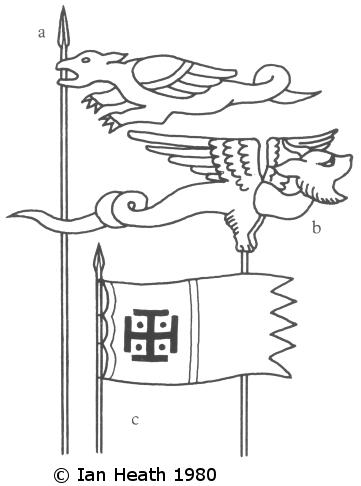
|
SAXON STANDARDS
An extract from Armies of the Dark Ages 600-1066
by Ian Heath
122. SAXON STANDARDS
122a and b are dragon standards, evolved once again from late Roman originals via the sub-Roman Britons.
The most famous was Alfred the Great's Golden Wyvern, the standard of Wessex.
We know that Edmund Ironside carried a dragon standard during his campaigns against Cnut, and 2 such standards appear in the Bayeux Tapestry.
The Mercian Saxons too seem to have used a golden dragon standard, King Aethelbald having one at Burford in 752,
though it may have been an embroidered banner rather than a windsock.
The Old Saxons too used dragon standards, such as that of the rebel leader Widukind in the late-8th century,
a banner with a dragon on one side and a lion on the other.
122a is one of the 2 dragon standards shown in the Tapestry,
one red and the other ochre (possibly representing gold).
Harold's personal standard at Hastings appears to have been the figure of an armed warrior embroidered in pure gold and decorated with precious stones.
Other Saxon banners in the Tapestry are of the type described under
126,
similar standards to which can be found in 10th century mss.
122b is from an early-14th century Arthurian romance but was almost certainly copied from an earlier Saxon original.
122c shows a religious standard, such as were often used when fighting the pagan Vikings. This one is from an 11th century ms.
[See a banner in the Tiberius Psalter, England (Winchester), c.1050. British Library Cotton Tiberius C VI]
[4 out of 5 dragon standards in L'Estoire de Merlin by Robert de Borron do not have wings.]
Next: 123. PEASANT INFANTRYMAN in Armies of the Dark Ages 600-1066 by Ian Heath
| |

